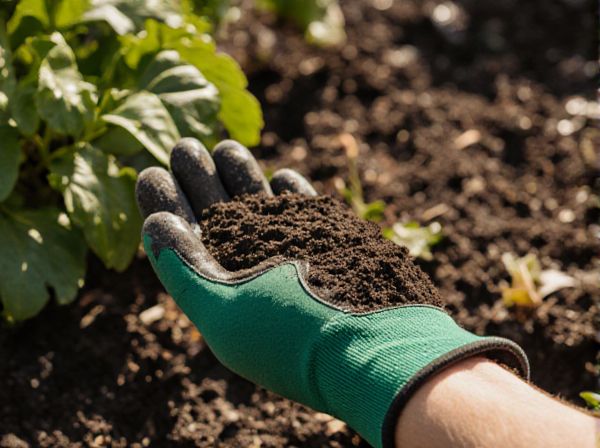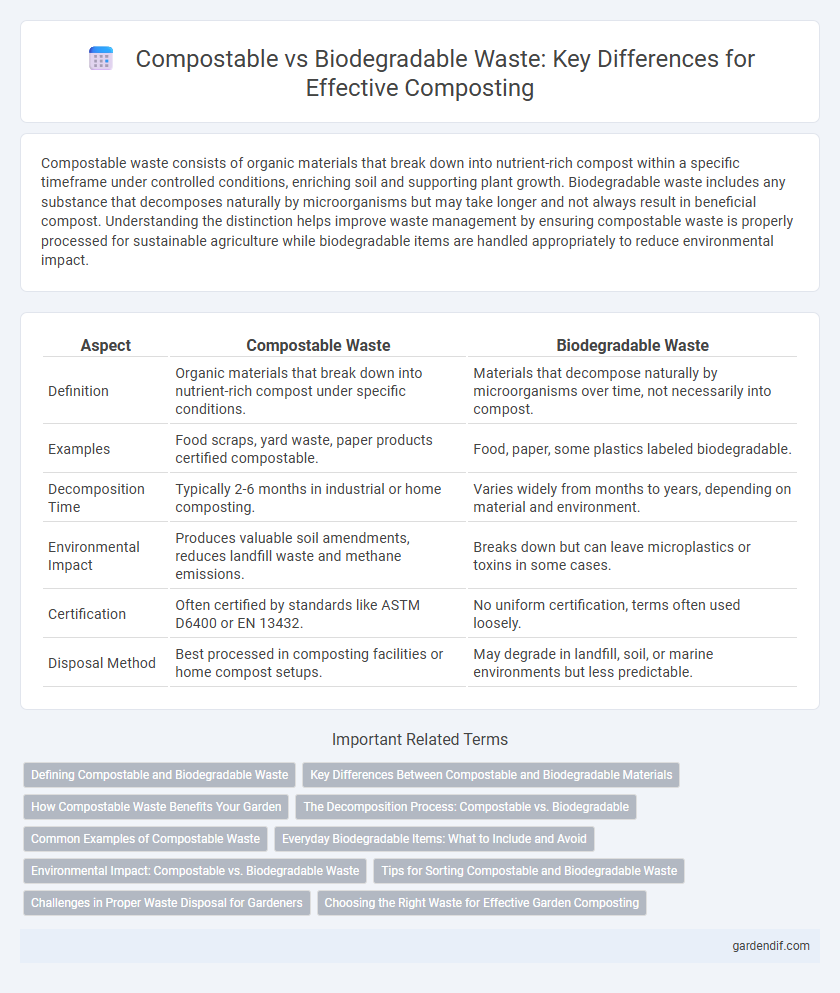
Compostable waste vs Biodegradable waste Illustration
Compostable waste consists of organic materials that break down into nutrient-rich compost within a specific timeframe under controlled conditions, enriching soil and supporting plant growth. Biodegradable waste includes any substance that decomposes naturally by microorganisms but may take longer and not always result in beneficial compost. Understanding the distinction helps improve waste management by ensuring compostable waste is properly processed for sustainable agriculture while biodegradable items are handled appropriately to reduce environmental impact.
Table of Comparison
| Aspect | Compostable Waste | Biodegradable Waste |
|---|---|---|
| Definition | Organic materials that break down into nutrient-rich compost under specific conditions. | Materials that decompose naturally by microorganisms over time, not necessarily into compost. |
| Examples | Food scraps, yard waste, paper products certified compostable. | Food, paper, some plastics labeled biodegradable. |
| Decomposition Time | Typically 2-6 months in industrial or home composting. | Varies widely from months to years, depending on material and environment. |
| Environmental Impact | Produces valuable soil amendments, reduces landfill waste and methane emissions. | Breaks down but can leave microplastics or toxins in some cases. |
| Certification | Often certified by standards like ASTM D6400 or EN 13432. | No uniform certification, terms often used loosely. |
| Disposal Method | Best processed in composting facilities or home compost setups. | May degrade in landfill, soil, or marine environments but less predictable. |
Defining Compostable and Biodegradable Waste
Compostable waste refers to organic materials that can decompose into nutrient-rich compost within a specific time frame under aerobic conditions, such as food scraps and yard trimmings. Biodegradable waste includes any material capable of being broken down by microorganisms over time, but not all biodegradable materials are suitable for composting due to slower decomposition rates or the presence of harmful residues. Understanding the distinction between compostable and biodegradable waste is essential for effective waste management and optimizing compost production.
Key Differences Between Compostable and Biodegradable Materials
Compostable materials break down into nutrient-rich soil within a specific timeframe under composting conditions, making them ideal for sustainable waste management. Biodegradable materials decompose naturally but without a guaranteed timeline or beneficial byproducts, often requiring varied environmental factors. Understanding these differences is crucial for optimizing organic waste disposal and enhancing soil health through effective composting practices.
How Compostable Waste Benefits Your Garden
Compostable waste, such as fruit peels, garden clippings, and paper products, breaks down into nutrient-rich humus that directly improves soil structure and fertility. Unlike biodegradable waste, which can decompose in various environments but may not enrich soil, compostable materials enhance microbial activity and water retention in garden soil. This nutrient boost supports robust plant growth, increased yield, and healthier soil ecosystems.
The Decomposition Process: Compostable vs. Biodegradable
Compostable waste undergoes decomposition through microbial activity in controlled environments, breaking down into nutrient-rich humus within 90 to 180 days, supporting soil health and plant growth. Biodegradable waste decomposes naturally by microbes, but the process varies widely in time and conditions, sometimes taking months to years, and does not always result in beneficial soil amendments. Understanding the distinction ensures effective waste management and optimal composting outcomes.
Common Examples of Compostable Waste
Common examples of compostable waste include fruit and vegetable scraps, coffee grounds, eggshells, grass clippings, and dry leaves, all of which break down efficiently in composting environments. These materials contain organic matter that microorganisms convert into nutrient-rich humus, enhancing soil health and fertility. Unlike some biodegradable wastes, compostable items degrade within a specific timeframe under controlled conditions, making them ideal for sustainable waste management systems.
Everyday Biodegradable Items: What to Include and Avoid
Everyday biodegradable items include fruit and vegetable scraps, coffee grounds, eggshells, and paper products such as napkins and cardboard, which break down naturally without harming the environment. Avoid including meat, dairy, oils, and synthetic materials in biodegradable waste as they decompose slowly and can attract pests or release harmful substances. Compostable waste specifically requires materials that decompose efficiently in industrial composting facilities, often labeled with certifications for proper disposal.
Environmental Impact: Compostable vs. Biodegradable Waste
Compostable waste breaks down into nutrient-rich organic matter that enhances soil health and reduces landfill methane emissions, offering a sustainable environmental benefit. Biodegradable waste decomposes naturally but may release methane if oxygen is absent, posing a greater risk to greenhouse gas accumulation. Prioritizing compostable materials in waste management reduces pollution and supports carbon sequestration, making it a more eco-friendly choice than general biodegradable waste.
Tips for Sorting Compostable and Biodegradable Waste
Properly sorting compostable and biodegradable waste enhances effective decomposition and reduces contamination in compost systems. Separate food scraps, coffee grounds, and yard trimmings as compostable waste, while ensuring biodegradable plastics or packaging labeled as certified compostable do not contain synthetic additives that hinder breakdown. Using clearly marked bins and educating household members on local composting guidelines helps maintain the balance and quality of organic material for optimal compost production.
Challenges in Proper Waste Disposal for Gardeners
Compostable waste decomposes into nutrient-rich compost under controlled conditions, while biodegradable waste breaks down naturally but may release methane in unmanaged environments. Gardeners often face challenges sorting these materials due to confusion over labeling and varying decomposition rates, leading to contamination in compost bins. Proper education on distinguishing compostable from biodegradable waste and implementing effective waste segregation is crucial for sustainable garden waste disposal.
Choosing the Right Waste for Effective Garden Composting
Compostable waste consists of organic materials like fruit scraps, vegetable peels, and coffee grounds that break down quickly into nutrient-rich humus, ideal for garden composting. Biodegradable waste includes items such as paper, cardboard, and certain bioplastics that decompose more slowly and may require specific conditions to recycle effectively in compost piles. Selecting compostable waste over generic biodegradable materials ensures faster decomposition and enhances soil fertility, promoting healthier plant growth in your garden.
Compostable waste vs Biodegradable waste Infographic

 gardendif.com
gardendif.com